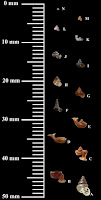 |
| Angustopila pallgergelyi Dumrongrojwattana, Chuenit & Wongkamhaeng, 2021 RAFFLES BULLETIN OF ZOOLOGY. 69 หอยจิ๋วถ้ำเพชรโพธิ์ทอง || facebook.com: Pongrat Dumrongrojwattana |
Abstract
This research describes a newly discovered cave-dwelling microsnail, Angustopila pallgergelyi, from Sa Kaeo Province, eastern Thailand. The new species’ conchology is similar to the cave-dwelling snail, A. tamlod (Panha & Burch, 1999) but differs in shell shape and apertural teeth development. The new species represents the smallest known member of Hypselostomatidae, with an average shell height of 0.66±0.03 mm (the shell height of the holotype is 0.64 mm), which is the smallest land snail species ever reported. Finally, an identification key to species is presented.
Key words. Hypselostomatidae, Angustopila, cave-dwelling snail, diversity, Thailand
TAXONOMY
Family Hypselostomatidae Zilch, 1959
Angustopila Jochum, Slapnik & Páll-Gergely
in Jochum, Slapnik, Kampschulte, Martels, Heneka & Páll-Gergely, 2014
Angustopila Jochum, Slapnik & Páll-Gergely
in Jochum et al., 2014: Zookeys, 410: 26.
Type species. Systenostoma tamlod Panha & Burch, 1999, by original designation.
Diagnosis. Shell extremely small, conical-shaped; whorls smooth, regular, moderately growing; protoconch recessed slightly into second whorl, sculptured with spiral and radial lines, surface powdery and reticulated; body whorl sometimes continues in profile past penultimate whorl; peristome slightly reflexed; aperture slight or non-adnate, usually one or two denticles.
Angustopila pallgergelyi Dumrongrojwattana, Chuenit & Wongkamhaeng, new species
Description. Shell minute, lenticular, white, apex blunt, spire lenticular with deep sutures (Figs. 2A, 3A, B); protoconch about one whorl, surface finely reticulate (Fig. 2B, C); teleoconch 4–4¼ rounded whorls, irregularly spaced growth lines crossed by rows of fine spiral threads forming fine reticulate sculpture (Fig. 2D); aperture broadly kidneyshaped, peristome slightly thickened, slightly expanded, slightly prosocline, detached from the body whorl; apertural teeth well developed, one parietal and one palatal directly opposite (Fig. 2E); umbilicus deep, relatively narrow.
Differential diagnosis. Angustopila pallgergelyi is similar to A. singuladentis by having a white shell, nearly smooth protoconch sculpture, and the teleoconch sculpture having irregular growth lines crossed with fine spiral threads, peristome slightly thickened and slightly expanded. The new species differs from A. singuladentis in some significant ways. The aperture is kidney-shaped (vs. circular in A. singuladentis); apertural teeth consist of parietal and palatal teeth (vs. only parietal tooth in A. singuladentis), and the whorl number ranges from 4–4.5 (vs. 3.5 in A. singuladentis) (Table 3). The apertural teeth of A. pallgergelyi consist of parietal and palatal teeth, and share this characteristic with only A. dominikae, A. huoyani, and A. tamlod. This new species can be distinguished from these three species by having teleoconch sculpture irregular growth lines crossed with fine spiral threads and the umbilicus deep and relatively narrow. In contrast, the other species have spiral threads and narrow umbilicus.
Etymology. This new species is named in honour of Dr. Barna Páll-Gergely, the Hungarian malacologist, in appreciation of his significant contributions to the study of microsnails.
Ecology. Living snails live in the dark and moisture zone of caves, gliding on the wall or hidden among coral-like stalactite (Fig. 3A, B). All type specimens were collected from soil sampled from the dark zone of Phet Pho Thong Cave, Sa Kaeo, approximately 300 metres from the entrance at the type locality. We assume that this new species is a cave-dweller, similar to A. tamlod.
Remarks. All specimens were collected inside the cave in Sa Kaeo Province, eastern Thailand, about 300 metres from the entrance. Among the previously described species, A. dominikae was the smallest known land snail (Pall-Gergely et al., 2015), with the shell height of the holotype being 0.86 mm. Angustopila pallgergelyi, new species, is even smaller (shell height of the holotype is 0.64 mm and shell heights of the paratypes 0.59–0.71 mm), and is therefore now the world’s smallest known terrestrial snail (Fig. 4).
Pongrat Dumrongrojwattana, Sirilan Chuenit and Koraon Wongkamhaeng. 2021. A New Species of the World’s Smallest Cave Snail of the Genus Angustopila Jochum, Slapnik & Páll-Gergely in Jochum, et al., 2014 (Gastropoda: Hypselostomatidae) from eastern Thailand. RAFFLES BULLETIN OF ZOOLOGY. 69; 102–108. DOI: 10.26107/RBZ-2021-0008















